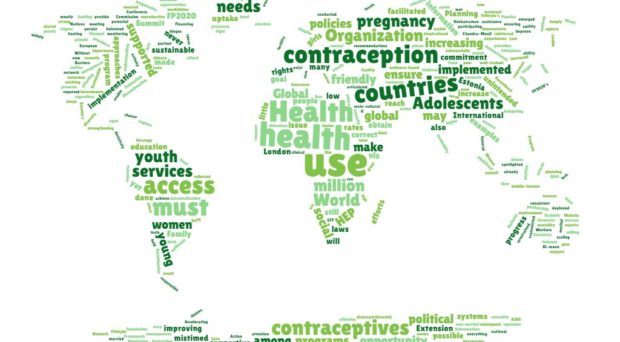
Q: What makes adolescent contraceptive use a significant global health issue?
A: The World Health Organization (WHO) reports 16 million adolescents aged 15-19 give birth each year, mostly in low and middle-income countries. Many are intended while others are mistimed; 23 million adolescents would like to use contraception but are not. Early, mistimed pregnancy may result in maternal morbidities and mortality, and social consequences that limit the potential of young women.
UN Secretary General Ban Ki-moon stated that adolescents “are central to everything we want to achieve.” If we are to reach FP2020’s goal of meeting the contraceptive needs of 120 million women and girls in 69 countries, attention to adolescents is seminal. A “never before” opportunity to prioritize the contraceptive needs and rights of adolescents has emerged, and we must act swiftly and decisively.
Q: Why are many adolescents still unable to obtain and use contraceptives?
Popular approaches to promote adolescent contraceptive use such as youth centers or peer education programs are still widely implemented, despite little or no effect in contraceptive uptake.
A: The International Conference on Population and Development spotlighted adolescents and contraception, yet 23 years later, little progress has been made. Barriers persist: restrictive laws, poorly implemented policies, reluctant providers and deeply held social norms, disproportionately affecting adolescent ability to use contraception to delay first pregnancy or space subsequent pregnancies.
Adolescents may not know where to obtain contraception or cannot afford services, yet even when there is easy access, uptake may be constrained by stigma around non-marital sexual activity, pressures to demonstrate fertility and overall lack of agency to make choices.
Incorrect use and discontinuation rates are also higher among adolescents. Popular approaches to promote adolescent contraceptive use such as youth centers or peer education programs are still widely implemented, despite little or no effect in contraceptive uptake.
Q: What should be done to increase correct and consistent contraceptive use by adolescents?
A: “Business as usual” approaches no longer suffice. We have a more robust understanding of what needs to be done, which must shared and supported at the country level, as efforts to improve adolescent contraceptive use hinges on political will. Scalable and sustainable responses are possible if countries are willing to:
- program against the diversity of adolescents;
- ensure adolescent access to all methods;
- forgo separate services and make services that already serve adolescents “youth friendly;”
- partner with pharmacies and drug shops as sources of contraception; and
- support all health workers to provide “youth friendly” care.
To further “bend the curve”, supportive laws and policies must be enacted, evidence-based interventions and monitoring systems must be implemented, and implementation research must be conducted.
In places where adolescents have good access to contraception, sufficient information, and are supported by the socio-cultural environment, there are low rates of unintended pregnancy. Adolescents can and do make responsible decisions when they have the tools and resources to do so.
Q: What are some examples of countries that have made great progress in increasing access to and use of contraceptives by adolescents?
In places where adolescents have good access to contraception, sufficient information, and are supported by the socio-cultural environment, there are low rates of unintended pregnancy.
A: The experiences of Ethiopia and Estonia in increasing adolescent contraceptive use and scaling up programs are instructive and inspirational:
Ethiopia’s National Health Extension Program (HEP) deployed 35,000 well-trained Health Extension Workers and ensured a steady supply of contraceptives. The HEP was intended to reach all Ethiopians, but the program substantially increased contraceptive use among married adolescents.
HEP success with adolescents was facilitated by policies that supported adolescent contraceptive use regardless of marital status, decentralization of implementation to the regions vis a vis planning and budgeting, and health management information systems that collected and reported relevant data.
Estonia, driven by high levels of unintended pregnancy, abortion and sexually transmitted infections among adolescents, scaled up comprehensive sexuality education in schools and a network of youth friendly clinical services. Estonia’s efforts were facilitated by a supportive social and political climate and the availability of sustainable funding through national health insurance as well as assistance from the International Planned Parenthood Federation European Network and the examples of other Scandinavian countries.
Q: What new opportunities now exist for improving adolescent health?
A: Without a doubt it is possible to increase adolescent contraceptive use and ensure positive outcomes for young people through effective programs, political will and a commitment to partnership with young people. The Global Financing Facility (GFF) is an exciting opportunity to translate rhetoric into action, bolstered by the Sustainable Development Goals and the Global Strategy for Women, Children and Adolescents, and reinforced by the recommendations of the 2016 Lancet Commission and WHO’s Accelerating Action for the Health of Adolescents Framework.
The Global Fund to Fight AIDS, Tuberculosis and Malaria has also demonstrated interest in strengthening its investments in adolescent health. Most recently, many of the FP2020 countries participating in the 2017 London Summit have articulated strong commitment to increasing adolescent contraceptive use. We have never had a better opportunity to ensure the reproductive health needs and rights of adolescents are met, and we must not squander this chance.
Thank you for this, it was very informative. I’d also recommend using innovative approaches when targeting youths such as mobile health or an app which was an approach taken by MSI Nepal to target the youth population. A supplement to providing youth friendly services is trying to make the health facilities ‘look’ youth friendly as well and less medicalized. I strongly agree that “business as usual” approaches no longer suffice.